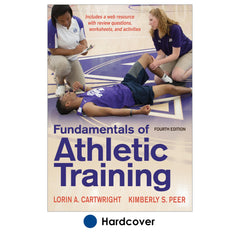Documentation and record keeping in athletic training
This is an excerpt from Fundamentals of Athletic Training 4th Edition With Web Resource by Lorin A Cartwright,Kimberly S Peer.
Data from injury reports should be recorded not only to reduce liability but also to track injury trends and make decisions about how best to treat these injuries. The benefit of computerized records is that they provide a database for future reference. These records can provide data regarding supply use, traffic flow in the athletic training room during peak times, specific injury patterns for each sport, rehabilitation equipment usage, and other valuable information that can be used to direct the functions in the athletic training room. In today's environment, numbers are powerful, and if the AT can prove that there is excessive need for perhaps another staff member or a new piece of equipment, the likelihood of acquiring support is stronger with numbers.
Records are also part of the legal system (see chapter 2). Documentation of everything that happens protects the athletic trainer throughout his career. That is why it is so important to have good, organized records that are prioritized and maintained regularly. Although one would hope to never need them in a legal case, records protect the AT and provide evidence of what was or was not done in a given situation.
Exactly which procedures must be documented is often debated. ATs should document any accident of which they are aware (even if it is not due to athletic participation), any treatment that an athlete receives, and the rehabilitation progress that an athlete makes. Many computer documentation or record-keeping systems are available to ATs. Computer systems make it easy to file injury reports, rehabilitation progress, and referral forms.
Records, in paper form, should be protected in locked file cabinets. Most systems require double locks, which means they are kept in a locked file cabinet behind a locked door. Computerized records should be secured through passwords, encryption, and other technical means. ATs should consult their technology experts to ensure appropriate security of all computerized records.
Accident and Injury Reports
Accident and injury reports contain vital information, including the athlete's name, the date of injury, the date of the report, the athlete's sport, the age of the athlete, and the body part that is injured. Additionally, the report must contain information about how the injury or accident occurred, whether it is a new or previous injury, and the AT's inspection and assessment information and signature. The report should also contain the AT's thoughts about the injury and record treatment such as ice application, splinting, or medical referral.
Go online to the Resources and Forms section of the web resource to find a printable injury report form.
Treatment Logs
Any treatment an athlete receives must be documented. Ice application, heat application, elastic wraps, stretching, strengthening, and so on must all be logged on a specific form.
Go online to the Resources and Forms section of the web resource to find a printable daily treatment log and treatment progress chart.
Rehabilitation Charts
Once an athlete has been injured, her injury assessed, and a proper rehabilitation program designed and implemented, it is essential that the AT document the athlete's progress. The AT must record the exact treatment received by the athlete, the date it was received, any problems or complaints, any changes in treatment, the athlete's response to treatment, and reevaluation data.
Injury-Tracking Systems
Injury-tracking systems have become very popular in athletic training. As athletic trainers try to prove their worth by getting national database information, computerized programs serve as the venue for compiling these records. Whether they are used exclusively for the AT program or as part of a larger initiative, injury-tracking systems provide valuable information for the athletic trainer. Although new systems emerge regularly, there are several that are quite popular in athletic training. Athletic Trainer System (ATS), SportsWare, Sports Injury Monitoring System (SIMS), SimTrack, NCAA, and Presagia Sports are the most prevalent software packages to date, and they have all been reviewed. When selecting a system, it is important to evaluate the following factors:
- Demographics
- Injury report
- Treatment reports
- Progress notes
- Medication log
- Physician referral
- Report generation
- Insurance information and claims
- Calendar
- Exercise flow sheet
- Price and annual fee
Each system has specific strengths and weaknesses. If you want to learn more about injury-tracking programs, do an internet search for “comparison of injury-tracking programs” and track the changes that have occurred over the years as technology has expanded.Selecting a program that is useful and appropriate for the AT's individual program is critical.
More Excerpts From Fundamentals of Athletic Training 4th Edition With Web Resource

Get the latest insights with regular newsletters, plus periodic product information and special insider offers.
JOIN NOW


